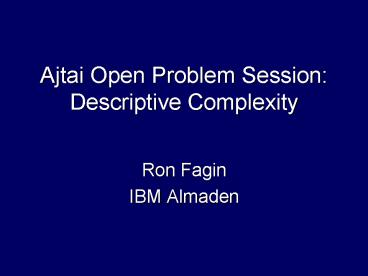Ajtai Open Problem Session: Descriptive Complexity PowerPoint PPT Presentation
1 / 14
Title: Ajtai Open Problem Session: Descriptive Complexity
1
Ajtai Open Problem Session Descriptive
Complexity
- Ron Fagin
- IBM Almaden
2
Ajtais paper
- Ajtai wrote a famous 1983 paper
- - formulae on finite structures
- Many results from that paper have been
rediscovered by others - Example Furst, Saxe and Sipsers 1984 result
that parity is not in AC0
3
What is ?
- -sentence ?Q1 ? ?Qm f(P,Q1,?,Qm)
- Here f is first-order, and P is, say, a binary
relation symbol, and so about graphs - Can define for more general structures than
graphs
4
Example 3-colorability
- Let P represent the graph relation
- Represent the 3 colors by Q1, Q2, Q3
- Let f(P,Q1,Q2,Q3) say Each point has exactly one
color, and no two points with the same color are
connected by an edge - Then ?Q1 ?Q2 ?Q3 f(P,Q1,Q2,Q3) says The graph is
3-colorable - So 3-colorability is
5
Connecting logic and complexity
- Theorem (Fagin 1974) NP
6
L-structures
- Let L be a signature, that is, a collection of
relation symbols - If L contains only a binary relation symbol, then
L is the language of graphs, and an L-structure
is simply a graph
7
A descriptive complexity hierarchy
- Let Sk(L) be those NP properties of L-structures
that can be defined using only k-ary
existentially quantified relation symbols. - Example If P is a binary relation symbol, then
Sk(P) consists of graph properties definable by a
sentence of the form - ?Q1 ? ?Qm f(P,Q1,?,Qm)
- with Q1,?, Qm k-ary
- S1(L) ? S2(L) ? S3(L) ?
- ?k Sk(L) the NP properties of L-structures
8
Monadic NP
- S1(L) is often called monadic NP
- Example 3-colorability
- Theorem (Fagin 1975) Graph connectivity is not
in monadic NP (although nonconnectivity is)
9
Is the hierarchy strict?
- Let P be a binary relation symbol
- Since graph connectivity is easily shown to be in
S2(P), it follows that S1(P) ? S2(P) - Open problem Does the hierarchy collapse to the
second level, so that every NP graph property is
in binary NP, that is, S2(P)?
10
A partial result
- Theorem (Fagin 1975) If Sk(L) Sk1(L), then
Sk (L) Sn(L), for all n with n ? k
11
A theorem from Ajtais famous 1983 paper
- Theorem (Ajtai 1983) Let R be a (k1)-ary
relation symbol. The parity of the number of
tuples in R is even is not in Sk(R) (although it
is in Sk1(R)) - In particular, NP goes beyond binary NP if we
consider richer structures than graphs
12
A sub-hierarchy of Sk(L)
- Let us fix k, the arity of the 2nd-order
quantifiers, and consider the number of these
quantifiers - When k1
- Theorem (Otto 1995) More monadic NP graph
properties can be expressed with r1 unary
quantifiers than with r
13
Refinements of open problem
- We asked Is there an NP graph property not
expressible in the form - ?Q1 ? ?Qm f(P,Q1,?,Qm),
- where the Qis are binary?
- Is there an NP graph property not expressible in
the form ?Q f(P,Q), where Q is binary? - Is there a co-NP graph property not expressible
in the form ?Q f(P,Q), where Q is binary? - Note that resolving these problems does not
settle P ? NP or NP ? co-NP
14
Open meta-problem
- What other wonderful jewels are hidden away in
Ajtais 1983 paper?

